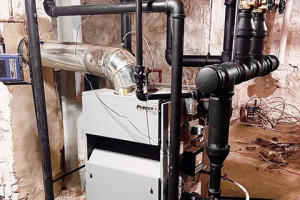
Hello, old friend. I’m writing today to say thanks, and to say farewell. This will be my last column.

I went to ISH in Frankfurt, Germany with three friends in 1995. It was my third trip to that monstrosity of a tradeshow and we had arranged with friends at Danfoss to visit a few buildings and meet some engineers who had designed them. Frankfurt is a big city with big buildings and bulging suburbs. It’s sort of like New York, but without the jaywalkers.
One of the jobs was a residential-housing development. There were tower cranes all over the place. I asked about those and our host told me that Germans love their cranes.
“We pass everything from one to the other,” he said, waving his arms like a juggler and pointing at the swinging loads.
“Nobody carries anything?” I asked.
“Why should we carry things? We have cranes.” He nodded at them and smiled.
“Oh.”
Poured concrete made up the walls, floors and ceilings of these houses. Thick, rigid insulation and brick formed the outer skin of each house. The roof was made of some sort of plastic. The windows looked like they could have been on submarines. They had radiant. The PEX tubing snapped into thick, insulated, plastic floor panels. I had never seen those before. The spacing varied from 2 inches to 6 inches on center.
“That’s a lot of PEX,” I said.
“Ya,” he replied.
“You have more PEX in one of these houses than most American wholesalers have in stock,” I said.
“Ya,” he said. “And we must insulate each floor for sound.” He pointed at the plastic floor panels.
“For sound?”
“Ya. So people in the house do not hear each other. We insulate for the loud voices, the music and the pounding feet. The children. You understand?"
“Why?”
“It’s the law,” he said. “This is Germany.”
“Oh.”
“Ya.”
“You must be able to heat this place with about 110° water,” I said, looking at the plethora of PEX.
He nodded. Smiled. “Ya,” he said.
That was March of 1995. Tom Hanks had just won the Academy Award for playing Forrest Gump. Sheryl Crow won the Grammy for “All I Wanna Do.”
Feeling old? Think for a moment about how we were building houses in America that year.
“We build houses to last hundreds of years,” the German engineer said.
“We don’t.”
He nodded. Smiled.
It was good to get away from the ISH show for a while and out into the field. I learned that those houses weren’t anything special by German standards. They were just regular houses for small families. They were expensive, sure, but that had a lot to do with how close they were to downtown Frankfurt.
And those houses will last for hundreds of years.
They insulate the floors so you don’t hear the kids upstairs. Seriously.
We next visited a large office building and I got to see louvered shades that shifted automatically in response to the angle of the sun.
I asked what that was all about because, after all, it was 1995, and I was a babe in the German woods back then. The engineer who was showing us around explained that glass is like a check valve for sunlight.
The light streams through a glass window and lands on a solid object. It bounces off the object with a different wavelength, one that can’t get back through the glass. He explained this is why it gets so hot inside your car on a summer day.
I told him on the Isle of Long, many people put these reflectors on the inside of their windshields to keep their cars cooler.
He smiled and nodded. Then, he explained the sunlight just heats the air between the reflector and the windshield and still makes the car hot. He told me if you want your car to stay cool, you would have to put the reflector on the outside of the windshield, not the inside.
“But then people would steal the reflectors,” I said.
“Ya.”
Then he told me this is why they put those moveable sun-louvers outside the building instead of inside. On subsequent trips to Europe, I saw mostly metal shades on the outsides of the windows. That was in every country I visited.
In America, we put the shades on the insides of the windows and compensate for the solar gain by oversizing the air-conditioning systems. Make sense? The German engineer didn’t think so either.
He took us into the boiler room where I saw all I had expected to see, except for the dirt and debris found in most American boiler rooms. Then, I spotted this very large tank squatted on the floor. It had supply-and-return heating pipes coming and going from it.
“What is this?” I said.
“It is the hydraulic separator,” he said.
“What’s inside of it?”
“Water.”
“No,” I said.
“I mean what else besides water.”
“Nothing else is necessary,” he said. “Just water.”
“What is its purpose?”
“It is the hydraulic disconnection for the pumps,” he said.
“Huh?”
Now again, please remember this was 1995 and the idea of a hydraulic separator was not yet dwelling in my American brain. It would take years before it was even a zygote in this country.
The engineer smiled and patiently explained how hydronic systems have big pumps and small pumps, and the big pumps can overcome the pressure differential the small pumps can create and stop the water flowing in the circuits served by the smaller pumps.
“The tank is a common point of very low pressure differential,” he said. “It’s the place where the big pumps and little pumps can disconnect.”
“This is just like primary/secondary pumping,” I said.
“Excuse me?” he said.
“Primary/secondary pumping,” I said. “It’s how we do it in America.”
I asked for some paper and pen, and drew what I thought was a respectable drawing of a typical system that had primary, secondary and even tertiary pumps.
“This is how we do it,” I said, pointing. “A man named Gil Carlson came up with the idea when I was a child. He was my teacher.”
The engineer looked at the drawing and shook his head. “This is not good,” he said.
“But this is how we do it,” I said. “It’s good. It works.”
“No,” he said. “It’s not good.”
“Why?”
“There are too many parts to it,” he said. “Too many fittings. Look.”
He pointed to all the closely spaced tees I had sketched.
“Not necessary,” he said. He took the pen from my hand and crossed them all out. Then he drew in his hydraulic-separation tank.
“Like this. Ya?”
“But that’s not how we do it,” I said.
Have you ever noticed how when someone disagrees with you about things that have to do with hydronics, or pretty much anything else in life, many of us tend to dig in our heels and start repeating ourselves, but louder each time?
That was me that day. I walked out of that building absolutely convinced the engineer with the big tank filled with water didn’t know what he was doing. He was wrong, and he was stupid because he refused to see our way was the best way. We’d been doing it our way for years. Couldn’t he see I was trying to help him?
Today, as I think about that younger man who used to wear my clothes, I can only smile and nod. I was the dumb one. I know that now.
These days, I marvel at hydraulic separators that do everything primary/secondary pumping can do, and then some. They create a low-pressure-drop point by providing a wide space in the road. That disconnects the pumps hydraulically, just like the closely spaced tees in our primary/secondary systems do, but without all the extra piping.
The hydraulic separators also eliminate air from the system. They provide a place for dirt to settle out of the flow and then leave the system for good. They grab all the ferrous metal particles flowing around and keep them from choking ECM motors to death. They make boiler rooms much easier to pipe. They save space, labor and money. They’ve been around and proven their value for a long time. And they look great.
You want to know what I’ve learned? It pays to get out into the world and listen to people. Just shut up and listen. Keep an open mind and think. Don’t be too quick to decide. Just listen and think.
These days, I often think about that dopey kid who used to wear my clothes. He thought he knew it all, but he had much to learn. I nod and I smile. Dopey kid.
Ya.

Hello, old friend. I’m writing today to say thanks, and to say farewell. This will be my last column.

My six-year-old grandboy, Brendan, was in the vestibule of the diner when the bubblegum machine caught his attention. It was one of those spiral models that appeared in t...

Subdural posed a question on The Wall at HeatingHelp.com in the Strictly Steam section, where some of the sharpest knives in the drawer post every day. The question was a...